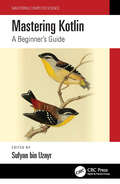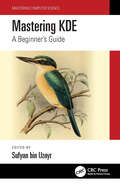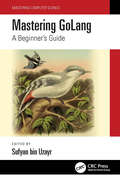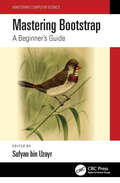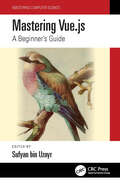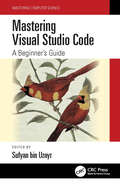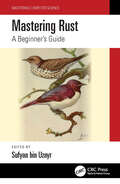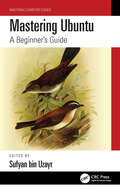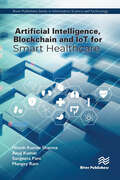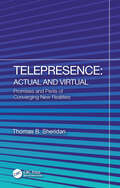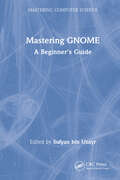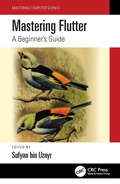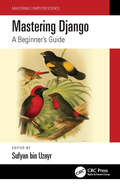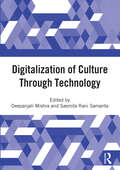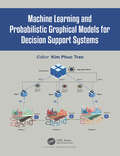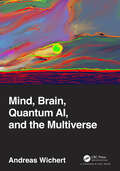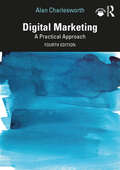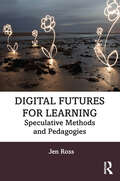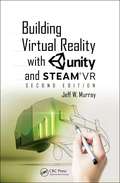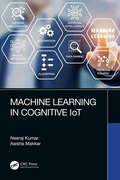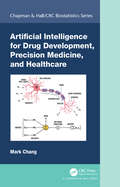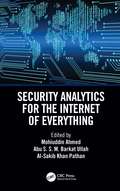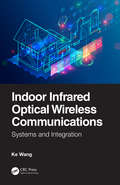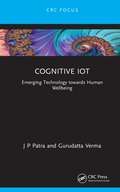- Table View
- List View
Mastering Kotlin: A Beginner's Guide (Mastering Computer Science)
by Sufyan Bin UzayrMastering Kotlin helps readers quickly understand core concepts and then move on to practical projects using the Kotlin programming language. Back in the day, Java was the de facto choice for creating Android apps. However, since Google announced Kotlin as the new language of choice for building Android applications, developers haven’t looked back. Kotlin is a general purpose, statically typed, open source programming language that runs on Java Virtual Machines. It can be called a Java replacement; however, the Kotlin syntax isn’t blindly identical to that of Java. Sure, Kotlin can work with Java, and owing to its intuitiveness, it can also enhance overall productivity and efficiency, but it is not a Java clone. Kotlin differs from Java in that it has assertive interfaces that help determine variable and expression classes, even if they’re not defined. Kotlin is a beautiful alternative for modifying and identifying faults because it has a familiar and straightforward syntax and programming structure. It comes with a sophisticated compiler that can track automatic casts, allowing verification durations to be more efficient. Kotlin also has simple signals that may be interpreted without any need for set parameters. And Kotlin is easy to set up: all you need is a Kotlin component for Android Studio. Kotlin developers are in high demand. As a Kotlin developer, you’ll be able to pursue a variety of career routes, spanning fields such as mobile app development, game development, game design, and even software development. Many well-known brands use Kotlin in their software and projects. Naturally, it is a good idea to learn Kotlin, and this is how Mastering Kotlin can be the right manual for you! With Mastering Kotlin, learning Kotlin becomes an easy task, and learners can use their skills to create innovative Kotlin apps. The Mastering Computer Science series is edited by Sufyan bin Uzayr, a writer and educator with over a decade of experience in the computing field.
Mastering KDE: A Beginner's Guide (Mastering Computer Science)
by Sufyan Bin UzayrMastering KDE helps the reader master the KDE desktop environment for a faster and more robust computing experience. The best thing about Linux is the plethora of choices that users tend to have. Whether it pertains to the kernel modules, or to the desktop environments, there is no shortage of options. Speaking of desktop environments, KDE stands tall as one of the leading options. KDE stands for K Desktop Environment, an open source desktop working platform featuring a graphical user interface (GUI). When KDE was first introduced, it was known as the Kool desktop environment, later renamed KDE. The KDE GUI includes everything a typical user would require, such as a file manager, window manager, help tool, and system settings. KDE is the default desktop environment for various Linux distros, and also has its own flagship distro, KDE Neon, that is covered at length in Mastering KDE. KDE comes with features that give users remote access to other devices, such as computers running Windows, Linux, macOS, or Android smartphones. KDE Connect, a Linux-based application, is one such solution that allows users to transfer data between multiple devices and operate them remotely. This book talks about everyday usage of KDE, including remote access and KDE development. With Mastering KDE, using KDE for day-to-day computing becomes simple and straightforward, which will undoubtedly help readers boost their productivity. The Mastering Computer Science series is edited by Sufyan bin Uzayr, a writer and educator with over a decade of experience in the computing field.
Mastering GoLang: A Beginner's Guide (Mastering Computer Science)
by Sufyan Bin UzayrMastering GoLang helps readers quickly understand the core concepts and then move on to practical projects using the Go programming language. GoLang is often dubbed a game-changer in the world of programming languages. Instead of starting from scratch, Go was created using the C programming language. GoLang inherits C’s disciplined grammar but with specific tweaks and enhancements to properly manage memory. This lessens the memory leakage problems that developers tend to face with C. Go borrows and adapts notions from various programming languages while skipping characteristics that result in complicated, insecure, and unpredictable code. Go’s concurrency features are well-suited to build the infrastructure for gigantic projects such as networking systems and distributed hardware. Go is also often employed in domains such as visuals, mobile applications, and Machine Learning. Even though GoLang is a relatively new language, it has been adopted by several major organizations owing to its benefits, which include code clarity, custom libraries, adaptability, multithreading, and a simple build process. Because Go is gaining traction in the development community, learning GoLang can open up new avenues across various fields and career trajectories. Since it is still a relatively newer language, quality literature pertaining to Go is often hard to find. This particular book covers all the bases that you might need, and is an ideal companion for beginner-level developers looking to master Go programming. With Mastering GoLang, learning GoLang becomes an easy task, and learners can use their skills to create innovative projects. The Mastering Computer Science series is edited by Sufyan bin Uzayr, a writer and educator with over a decade of experience in the computing field.
Mastering Bootstrap: A Beginner's Guide (Mastering Computer Science)
by Sufyan Bin UzayrMastering Bootstrap helps the reader master Bootstrap CSS framework for faster and robust front-end development. If you work in the web development world, you must have heard about Bootstrap, a comprehensive toolkit that includes HTML, CSS, and JavaScript tools for creating and developing web pages and apps. Ever since it was released as an open-source project in 2011, Bootstrap has attracted increasing attention for legitimate reasons. Bootstrap is popular among web designers and developers since it is versatile and straightforward. Its significant characteristics are that it is adaptive by aesthetics, supports a colossal spectrum of browsers, and provides a reliable configuration by employing reusable components. It is simple to use and understand. Bootstrap consists of a source code version and an executable version. Software engineers use Bootstrap for a variety of reasons. The Grid System in Bootstrap is popular mainly because it is simple to set up and master, with many components, styling for numerous HTML elements ranging from typography to buttons, and JavaScript plugin compatibility, all of which makes it even more versatile. For a web designer, learning Bootstrap is almost imperative today since it allows your website to look good on every screen resolution and adaptable on every device without much effort. This will make your site appear more presentable, reduce development time, and be more convenient since it is simple to learn and execute. Many businesses continue to use it; hence it is a valuable talent. As a career option, knowing Bootstrap might be a massive help if you want to work as a web developer. This is true whether you specialize in front-end or back-end web development. Bootstrap can help you save time and ensure that your websites are mobile-friendly and responsive. With Mastering Bootstrap, learning Bootstrap becomes a charm, and will undoubtedly help readers advance their careers. The Mastering Computer Science series is edited by Sufyan bin Uzayr, a writer and educator with more than a decade of experience in the computing field.
Mastering Vue.js: A Beginner's Guide (Mastering Computer Science)
by Sufyan Bin UzayrMastering Vue.js helps the reader master the Vue.js JavaScript framework for faster and more robust front-end development. Vue is a popular JavaScript front-end framework that is rapidly expanding. It is easy to use, small (less than 24 KB), and really fast. It is simple to include in other applications and libraries. Vue.js is easy to install, and beginners may quickly learn how to use it and begin creating their interface design. What makes Vue special is that it is different from most other JavaScript frameworks and libraries. Unlike other monolithic frameworks, Vue is built from the ground up to be incrementally adaptable. The core library focuses primarily on the View layer, and is easy to use and combine with other libraries or projects. On the other hand, when merged with contemporary stacks and libraries, Vue is perfectly capable of running powerful Single-Page Web Applications. Working with Vue.js can be fun. Leveraging Vue and its plugins can help one easily create excellent Internet and smartphone-compatible applications. Vue is both compact and customizable, and comes with multiple capabilities for intelligent state management and navigation choices. All said and done, learning Vue is an excellent career initiative, especially since it is rapidly gaining favor among startups and established enterprises alike. Vue is an excellent choice if you want to make a highly engaging, flexible, and data-driven app. It has an easy-to-understand layout which you can learn in minutes. Unlike Angular or React, Vue.js does not have a lot of challenges or concepts to master. It is an excellent choice for programmers looking to learn and implement new technology for their next project. With Mastering Vue.js, learning Vue becomes very straightforward, which will help readers undoubtedly advance their careers. The Mastering Computer Science series is edited by Sufyan bin Uzayr, a writer and educator with over a decade of experience in the computing field.
Mastering Visual Studio Code: A Beginner's Guide (Mastering Computer Science)
by Sufyan Bin UzayrMastering Visual Studio Code empowers the readers to get the most out of VS Code, an extremely popular and powerful code editor. Microsoft’s Visual Studio Code (VS Code) is a free and open-source code and text editor. Despite its modest size, VS Code includes numerous significant features that have made it one of the most popular code editors in recent years. VS Code is compatible with various programming languages, including Java, C++, Python, CSS, Go, and Docker files. VS Code also lets you add and create new extensions, such as code linkers, debuggers, and support for cloud and web development. Compared to other text editors, the VS Code user interface allows for a lot of interactivity. Some of the major advantages of Visual Studio Code are: • Cross-stack development using an open technology platform • Huge repository of plug-ins produced by the community and professionals • Debug tools for generic usage • Cross-platform support, including Linux, Mac, and Windows A good and powerful code editor is a vital part of any developer’s toolkit. VS Code has all the features any developer might need. As such, learning Visual Studio Code and understanding its various offerings and features is a good idea. With Mastering Visual Studio Code, using VS Code will become a breeze, regardless of the language that you are coding in, thereby boosting your productivity. The Mastering Computer Science series is edited by Sufyan bin Uzayr, a writer and educator with more than a decade of experience in the computing field.
Mastering Rust: A Beginner's Guide (Mastering Computer Science)
by Sufyan Bin UzayrMastering Rust helps the reader master the powerful Rust programming language for creating stable and versatile applications and projects. Rust is a dependable and robust programming language that was created with today’s needs in mind, which is something that several other scripting languages lack. Rust was developed to provide high functions comparable to those of C and C++, and with a focus on code integrity, which is, arguably, lacking in languages such as C. Rust is a dynamically typed language that emphasizes performance and reliability, particularly in parallelism and storage organization. Rust allows you to store data on the tower or the shedload, and it recognizes the importance of performance optimization. It permits even more effective memory usage as well as faster memory management than most other programming languages in its league. Make no mistake about it – Rust is a programming language with a strong learning curve, and is considered complicated by even the most experienced of developers. The rewards for learning Rust are aplenty, but the learning process itself requires a good deal of determination and hard work. Nonetheless, Rust aims to provide a secure, concurrent, and practical systems language in ways that other programming languages do not, and this is primarily why Rust is often the preferred choice for building complex and highly stable apps. Rust boasts of advantages over many other programming languages in terms of expressiveness, speed, sound design, and memory storage. Though the language is new and constantly changing with time, there is an excellent opportunity in this field for future employment. That said, to learn the reliable language that is Rust, you need to have an equally reliable companion guide in your hands, and this is where Mastering Rust comes in. With Mastering Rust, learning Rust programming language becomes a charm, and will undoubtedly help readers advance their careers. The Mastering Computer Science series is edited by Sufyan bin Uzayr, a writer and educator with more than a decade of experience in the computing field.
Mastering Ubuntu: A Beginner's Guide (Mastering Computer Science)
by Sufyan Bin UzayrMastering Ubuntu helps the reader learn the ropes in Ubuntu for a faster and robust computing experience. Ubuntu is a free Linux OS created by the Canonical community. It is highly customizable and features a Software Center full of apps, in addition to being open source. Ubuntu is one of the most popular distributions due to its simplicity. It has found good traction among universities and research groups because it combines all of the functionality of a UNIX OS with a customized graphical user interface. But just because it is free doesn’t mean Ubuntu lacks the bells and whistles. It has every ingredient that a successful operating system should have, including desktop apps for a variety of purposes, such as: • Support for all the modern web browsers, including Chrome, Firefox, Edge, and Opera • Office and productivity apps • Video players, audio players, and multimedia apps • A slick and intuitive user interface • Regularly patched security updates and bug fixes • A robust and reliable development cycle Ubuntu is ideal for beginners and advanced users alike. Regardless of skillset, users can quickly get to speed with Ubuntu Linux for everyday usage. This is where Mastering Ubuntu comes in. With Mastering Ubuntu, using Ubuntu for day-to-day computing becomes a charm. This book will help readers undoubtedly boost their productivity. The Mastering Computer Science series is edited by Sufyan bin Uzayr, a writer and educator with more than a decade of experience in the computing field.
Artificial Intelligence, Blockchain and IoT for Smart Healthcare
by Mangey Ram Anuj Kumar Hitesh Kumar Sharma Sangeeta PantThe concepts of telemedicine and e-healthcare have eased as well as improved the reachability of experienced doctors and medical staff to remote patients. A patient who is living in a remote village area can directly connect to specialist doctors across the globe though his/her mobile phone using telemedicine systems and e-healthcare services. In pandemic situations like COVID-19, these online platforms helped society to get medical treatment from their residence without any physical movement. Technology is transforming human lives by playing an important role in the planning, designing, and development of intelligent systems for better service. This book presents a cross-disciplinary perspective on the concept of machine learning, blockchain and IoT by congregating cutting-edge research and insights. It also identifies and discusses various advanced technologies such as internet of things (IoT), big data analytics, machine learning, artificial intelligence, cyber security, cloud computing, sensors and so on that are vital to foster the development of smart healthcare and telemedicine systems by providing effective solutions to the medical challenges faced by humankind.
Telepresence: Promises and Perils of Converging New Realities
by Thomas B. SheridanTelepresence: Actual and Virtual explores the history of telepresence from the 1948 developments of master–slave manipulation, through to current telepresence technology used in space, undersea, surgery and telemedicine, operations in nuclear and other hazardous environments, policing and surveillance, agriculture, construction, mining, warehousing, education, amusement, social media, and other contexts. It also describes the various operator hand and body controls and the corresponding telerobotic actuation of robotic hands, arms, and locomotion. This book reviews the sensing and control technology, its history and likely future, and discusses the many research and policy issues that are raised. The book also takes up key questions relating to social and ethical issues, given that a person’s mechanical reach is becoming unlimited, enabling one to perform mischievous or harmful acts without identification, and what that portends for future developments in telepresence, including regulation and recommended directions of development. The primary audience for this book is professionals interested in human–robot interaction, human factors engineering, virtual reality, applications to space and undersea exploration, telemedicine and telesurgery, firefighting, mechanized agriculture, policing, drone surveillance, warehouse parts' fetching, mining, and military operations.
Mastering GNOME: A Beginner's Guide (Mastering Computer Science)
by Sufyan Bin UzayrMastering GNOME helps the reader master the GNOME desktop environment for a faster and more robust computing experience. The best thing about Linux is the plethora of choices that users tend to get. Whether it pertains to the kernel modules, or to the desktop environments, there is no shortage of options. Speaking of desktop environments, GNOME stands tall as one of the leading options. GNOME is an open source, free to use, simple, and attractive workspace interface supporting almost all the major Linux operating systems. GNOME includes a beautiful collection of programs, libraries, plugins, and probably millions of themes (some of which you may need to install manually). In fact, one of the most exemplary aspects of GNOME is GNOME Boxes, which allows you to construct virtual networks of multiple Linux operating systems without having to visit the website or download an iOS file, and it runs perfectly well via virtualization on KVM, which is the icing on the cake. But that is not all – GNOME is, arguably, the single most stable and dependable Linux desktop environment available today! GNOME has become one of the most effective, secure, and trustworthy desktops offered for the Linux platform, and that is the primary reason why it is the desktop environment of choice for Ubuntu, the world’s most popular Linux distro. Regardless of skillset, users can quickly get up to speed with GNOME for everyday usage. This is where Mastering GNOME comes in. With Mastering GNOME, using GNOME for day-to-day computing becomes quite straightforward, which will help readers undoubtedly boost their productivity. The Mastering Computer Science series is edited by Sufyan bin Uzayr, a writer and educator with over a decade of experience in the computing field.
Mastering Flutter: A Beginner's Guide (Mastering Computer Science)
by Sufyan Bin UzayrMastering Flutter helps the reader master the popular Flutter framework for rapid cross-platform app development. Mobile applications grow in popularity every year, and developers keep looking for new tools to help them design them. A Google-backed, free and open-source mobile user interface framework, Flutter, stands out among these products. Flutter enables developers to construct a native mobile app using just a single line of code. This implies that one could design two different applications using the same programming language and codebase (iOS and Android). Flutter comprises two main components: a Framework and a Software Development Kit (SDK). You will use the Dart programming language to create Flutter apps. Dart is an object-oriented programming language with data types and its own paradigm. The best part about Flutter is that you can use it to create apps for iOS, Android, desktop, and the web, all with the same codebase. Flutter comes with a widget-based UI library, a collection of UI elements (text boxes, picture blocks, buttons, and so on) that can be used to customize and construct apps. Consider Flutter to be the app’s frontend user interface and Dart to be the backend code that is generated automatically. Flutter is considerably easier to understand and use, perfect for creating MVPs. It is also supported by a variety of Integrated Development Environments. Long story short, Flutter is paving the way for the future. Several companies have already begun using Flutter for cross-platform development. In fact, even Ubuntu Linux supports Flutter-based desktop apps. As such, learning Flutter can be a career-defining move for any coder. With Mastering Flutter, learning Flutter becomes straightforward, which will help readers undoubtedly advance their careers. The Mastering Computer Science series is edited by Sufyan bin Uzayr, a writer and educator with over a decade of experience in the computing field.
Mastering Django: A Beginner's Guide (Mastering Computer Science)
by Sufyan Bin UzayrMastering Django helps the reader master the powerful Django framework for Python for creating dynamic applications and projects. Django is a high-level, open-source Python web framework created to help web developers achieve tight deadlines while also meeting a variety of needs. The primary feature of Django that makes it so popular among developers is that it promotes rapid development while providing a consistent and realistic design. Django is a complete toolkit with a basic code architecture and highly adaptable architecture that promotes rapid development — it can shape and pace your web app concept and see it through to launch in a matter of hours. Django's simplicity, stability, scalability, and flexibility are unmatched. It is currently a vibrant, collaborative open source project with thousands of users and contributors. Django is a versatile framework capable of developing any website. Robust design, rapid software development, fantastic documentation and tutorials, a vast community with readymade solutions,reasonably easy learning curve, and a high degree of clarity and readability are all hallmarks of this popular web framework. Django has carved out a niche for itself in the industry over the years, and appropriately so. Many popular apps use Django as their secret ingredient. Django has many faetures and can accommodate any modern web application. If you wish to build a successful career in web development, learning Django is a wise choice. With Mastering Django, learning the Django framework becomes a charm, and will help readers undoubtedly advance their careers. About the Series The Mastering Computer Science covers a wide range of topics, spanning programming languages as well as modern-day technologies and frameworks. The series has a special focus on beginner-level content, and is presented in an easy to understand manner, comprising: Crystal-clear text, spanning various topics sorted by relevance, Special focus on practical exercises, with numerous code samples and programs, A guided approach to programming, with step by step tutorials for the absolute beginners, Keen emphasis on real-world utility of skills, thereby cutting the redundant and seldom-used concepts and focusing instead of industry-prevalent coding paradigm, A wide range of references and resources, to help both beginner and intermediate-level developers gain the most out of the books. Mastering Computer Science series of books start from the core concepts, and then quickly move on to industry-standard coding practices, to help learners gain efficient and crucial skills in as little time as possible. The books assume no prior knowledge of coding, so even the absolute newbie coders can benefit from this series. Mastering Computer Science series is edited by Sufyan bin Uzayr, a writer and educator with over a decade of experience in the computing field.
Digitalization of Culture Through Technology: Proceedings of the International Online Conference On Digitalization And Revitalization Of Cultural Heritage Through Information Technology- ICDRCT-21, 23-24 Nov 2021, KIIT University, Bhubaneswar
by Deepanjali Mishra Sasmita Rani SamantaIn the era of digitalization, the world has shrunk and has succeeded in bringing people closer than expected. It has provided a social platform which enables people to interact with an individual, group of users anywhere irrespective of time. It has assisted in various academic, non academic as well as social activities which has made lives more easier. Various researches have been conducted that explored the versatile use of the Internet by the language communities and there has been growing research with various strands based on the possibilities of new technologies for the revitalization as well as for the documentation and preservation of cultures. Digitalization could indeed be the best possible methodology to revive the indigenous culture and folk traditions and practices all over the world and would be useful to demonstrate innovative technologies and prototypes, including digital repositories, digital archives, virtual museums and digital libraries, which result from established practices and achievements in the field. This volume brings out the contributions of renowned researchers, academicians and folklorists across the globe. It will be a resource to all researchers, linguistics and learners in the field of Digitalization of Cultural Studies.
Machine Learning and Probabilistic Graphical Models for Decision Support Systems
by Kim Phuc TranThis book presents recent advancements in research, a review of new methods and techniques, and applications in decision support systems (DSS) with Machine Learning and Probabilistic Graphical Models, which are very effective techniques in gaining knowledge from Big Data and in interpreting decisions. It explores Bayesian network learning, Control Chart, Reinforcement Learning for multicriteria DSS, Anomaly Detection in Smart Manufacturing with Federated Learning, DSS in healthcare, DSS for supply chain management, etc. Researchers and practitioners alike will benefit from this book to enhance the understanding of machine learning, Probabilistic Graphical Models, and their uses in DSS in the context of decision making with uncertainty. The real-world case studies in various fields with guidance and recommendations for the practical applications of these studies are introduced in each chapter.
Mind, Brain, Quantum AI, and the Multiverse
by Andreas WichertMind, Brain, Quantum AI, and the Multiverse There is a long-lasting controversy concerning our mind and consciousness.This book proposes a connection between the mind, the brain, and the multiverse. The author introduces the main philosophical ideas concerning mind and freedom, and explains the basic principles of computer science, artificial intelligence of brain research, quantum physics, and quantum artificial intelligence. He indicates how we can provide an answer to the problem of the mind and consciousness by describing the nature of the physical world. His proposed explanation includes the Everett Many-Worlds theory. Mind, Brain, Quantum AI, and the Multiverse tries to avoid any non-essential metaphysical speculations. The book is an essential compilation of knowledge in philosophy, computer science, biology, and quantum physics. It is written for readers without any requirements in mathematics, physics, or computer science.
Digital Marketing: A Practical Approach
by Alan CharlesworthDigital Marketing: A Practical Approach provides a step-by-step and comprehensive guide to implementing the key aspects of digital marketing. Building on the previous editions, this fully updated fourth edition takes an approach that prepares students for an active role in digital marketing. As well as topic-based exercises, the text also includes practical case-study exercises – based on theory and recognized good practice – which will ensure that readers will be able to analyse situations within the work place, identify the most appropriate course of action and implement the strategies and tactics that will help the organization meet its online objectives. Key updates to the new edition include: o The role of the digital influencer. o Direct to Consumer (DTC) and omni-channel retailing. o Individuals’ privacy and the role of organizations in gathering and storage of their personal data. o Ethical aspects of digital marketing and its impact on the environment. o SEO and Google’s development of the ‘zero click’. o Online ad fraud. o Updated online resources available via the author’s own site. This essential text equips advanced undergraduate, postgraduate and executive education students with the tools to undertake any digital marketing role within a variety of organizations. Comprehensive support material available online for both students and instructors includes links to articles and opinion pieces, PowerPoint lecturer slides and questions based on the chapter material.
Digital Futures for Learning: Speculative Methods and Pedagogies
by Jen RossDigital Futures for Learning offers a methodological and pedagogical way forward for researchers and educators who want to work imaginatively with "what’s next" in higher education and informal learning. Today’s debates around technological transformations of social, cultural and educational spaces and practices need to be informed by a more critical understanding of how visions of the future of learning are made and used, and how they come to be seen as desirable, inevitable or impossible. Integrating innovative methods, key research findings, engaging theories and creative pedagogies across multiple disciplines, this book argues for and explores speculative approaches to researching and analysing post-compulsory and informal learning futures – where we are, where we might go and how to get there.
Introduction to Wavelet Transforms
by Nirdosh BhatnagarThe textbook, Introduction to Wavelet Transforms provides basics of wavelet transforms in a self-contained manner. Applications of wavelet transform theory permeate our daily lives. Therefore it is imperative to have a strong foundation for this subject. Features No prior knowledge of the subject is assumed. Sufficient mathematical background is provided to complete the discussion of different topics. Different topics have been properly segmented for easy learning. This makes the textbook pedagogical and unique. Notation is generally introduced in the definitions. Relatively easy consequences of the definitions are listed as observations, and important results are stated as theorems. Examples are provided for clarity and to enhance reader's understanding of the subject. Each chapter also has a problem section. A majority of the problems are provided with sufficient hints. The textbook can be used either in an upper-level undergraduate or first-year graduate class in electrical engineering, or computer science, or applied mathematics. It can also be used by professionals and researchers in the field who would like a quick review of the basics of the subject. About the Author: Nirdosh Bhatnagar works in both academia and industry in Silicon Valley, California. He is also the author of a comprehensive two-volume work: Mathematical Principles of the Internet, published by the CRC Press in the year 2019. Nirdosh earned M.S. in Operations Research, and M.S. and Ph.D. in electrical engineering, all from Stanford University, Stanford, California..
Building Virtual Reality with Unity and SteamVR
by Jeff W MurrayBuilding Virtual Reality with Unity and Steam VR takes a hands-on approach to getting up and running with virtual reality using the Unity game engine. By utilizing the free SteamVR 2.x libraries, this book and its example code are compatible with the main virtual reality (VR) head-mounted displays currently available. This book also looks at some of the main issues surrounding virtual reality, such as motion sickness and performance issues, providing practical ways to reduce their impact to make better VR experiences. Key Features: Discusses some of the key issues facing virtual reality and provides helpful tips for making better VR experiences Practical examples geared to work with any headset compatible with SteamVR, including Oculus Rift, HTC Vive, and Valve Index Uses the SteamVR Interaction system for interactions such as picking up and throwing objects, operating user interfaces and capturing input events for your own scripts Explore advanced spatialized audio with Steam Audio. Discover how to build user interfaces for virtual reality, as well as discussing some best practices for VR-based user interface design Written by a games industry veteran with a proven track record, having worked for IBM Research in educational VR research projects and having made and launched VR experiences.
Machine Learning in Cognitive IoT
by Neeraj Kumar Aaisha MakkarThis book covers the different technologies of Internet, and machine learning capabilities involved in Cognitive Internet of Things (CIoT). Machine learning is explored by covering all the technical issues and various models used for data analytics during decision making at different steps. It initiates with IoT basics, its history, architecture and applications followed by capabilities of CIoT in real world and description of machine learning (ML) in data mining. Further, it explains various ML techniques and paradigms with different phases of data pre-processing and feature engineering. Each chapter includes sample questions to help understand concepts of ML used in different applications. Explains integration of Machine Learning in IoT for building an efficient decision support system Covers IoT, CIoT, machine learning paradigms and models Includes implementation of machine learning models in R Help the analysts and developers to work efficiently with emerging technologies such as data analytics, data processing, Big Data, Robotics Includes programming codes in Python/Matlab/R alongwith practical examples, questions and multiple choice questions
Artificial Intelligence for Drug Development, Precision Medicine, and Healthcare (Chapman & Hall/CRC Biostatistics Series)
by Mark ChangArtificial Intelligence for Drug Development, Precision Medicine, and Healthcare covers exciting developments at the intersection of computer science and statistics. While much of machine-learning is statistics-based, achievements in deep learning for image and language processing rely on computer science&’s use of big data. Aimed at those with a statistical background who want to use their strengths in pursuing AI research, the book: · Covers broad AI topics in drug development, precision medicine, and healthcare. · Elaborates on supervised, unsupervised, reinforcement, and evolutionary learning methods. · Introduces the similarity principle and related AI methods for both big and small data problems. · Offers a balance of statistical and algorithm-based approaches to AI. · Provides examples and real-world applications with hands-on R code. · Suggests the path forward for AI in medicine and artificial general intelligence. As well as covering the history of AI and the innovative ideas, methodologies and software implementation of the field, the book offers a comprehensive review of AI applications in medical sciences. In addition, readers will benefit from hands on exercises, with included R code.
Security Analytics for the Internet of Everything
by Al-Sakib Khan Pathan Mohiuddin Ahmed Abu S. S. M. Barkat UllahSecurity Analytics for the Internet of Everything compiles the latest trends, technologies, and applications in this emerging field. It includes chapters covering emerging security trends, cyber governance, artificial intelligence in cybersecurity, and cyber challenges. Contributions from leading international experts are included. The target audience for the book is graduate students, professionals, and researchers working in the fields of cybersecurity, computer networks, communications, and the Internet of Everything (IoE). The book also includes some chapters written in a tutorial style so that general readers can easily grasp some of the ideas.
Indoor Infrared Optical Wireless Communications: Systems and Integration
by Ke WangThis book aims to give an overview of recent developments in indoor near-infrared optical wireless communication technologies and systems, including basic theories, operating fundamentals, system architectures, modelling, experimental demonstrations, advanced techniques, and most recently, the research efforts towards integrations. Both line-of-sight and diffusive-signals-based options will be reviewed, to provide readers a complete picture about this rapidly developing area, which targets the provision of high-speed wireless connectivity to end- users in indoor environments, such as offices, homes and shopping centres, to satisfy the growing high-speed communication requirement. Provides a systematic approach for the fundamentals of indoor optical wireless communications. Provides an overview of recent developments in indoor infrared optical wireless communications, including theoretical fundamentals. Examines system architectures, modelling, experimental demonstrations, and the research efforts towards integrations. Dr. Ke Wang is an Australian Research Council (ARC) DECRA Fellow and a senior lecturer in the School of Engineering, Royal Melbourne Institute of Technology (RMIT University), VIC, Australia. He worked with the University of Melbourne, Australia, and Stanford University, California, before joining RMIT University. He has published over 110 peer-reviewed papers in top journals and leading international conferences, including over 20 invited papers. He has been awarded several prestigious national and international awards as recognition of research contributions, such as the Victoria Fellowship, the AIPS Young Tall Poppy Science Award, and the Marconi Society Paul Baran Young Scholar Award. His major areas of interest include: silicon photonics integration, opto-electronics integrated devices and circuits, nanophotonics, optical wireless technology for short-range applications, quasi-passive reconfigurable devices and applications and optical interconnects in data -centres and high-performance computing.
Cognitive IoT: Emerging Technology towards Human Wellbeing (Intelligent Signal Processing and Data Analysis)
by J P Patra Gurudatta VermaThis book deals with a different research area of cognitive IoT and explains how machine learning algorithms can be applied for cognitive IoT. It deals with applications of cognitive IoT in this pandemic (COVID-19), applications for student performance evaluation, applications for human healthcare for chronic disease prediction, use of wearable sensors and review regarding their energy optimization and how cognitive IoT helps in farming through rainfall prediction and prediction of lake levels. Features: Describes how cognitive IoT is helpful for chronic disease prediction and processing of data gathered from healthcare devices. Explains different sensors available for health monitoring. Explores application of cognitive IoT in COVID-19 analysis. Discusses pertinent and efficient farming applications for sustaining agricultural growth. Reviews smart educational aspects such as student response, performance, and behavior and instructor response, performance, and behavior. This book aims at researchers, professionals and graduate students in Computer Science and Engineering, Computer Applications and Electronics Engineering, and Wireless Communications and Networking.
